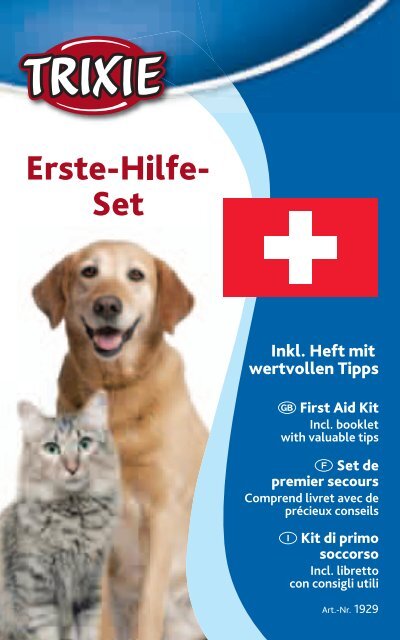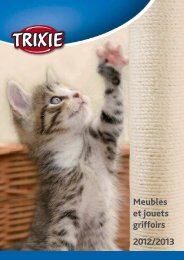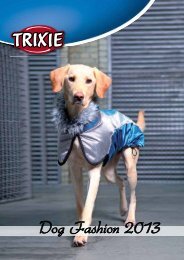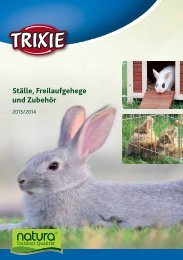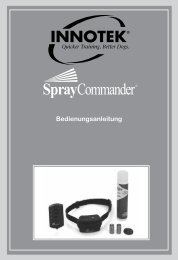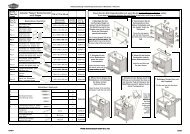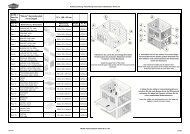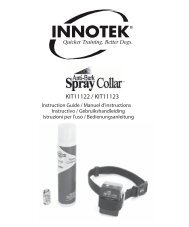First Aid Tips - Trixie
First Aid Tips - Trixie
First Aid Tips - Trixie
Create successful ePaper yourself
Turn your PDF publications into a flip-book with our unique Google optimized e-Paper software.
Inhalt Einsatzmöglichkeiten<br />
1 Erste-Hilfe-Tasche<br />
2 1 Wundkompresse<br />
10 × 10 cm, steril<br />
3 1 Verbandpäckchen<br />
6 × 400 cm, steril<br />
sterile Abdeckung einer Wunde<br />
Verband mit integrierter Wundkompresse<br />
zur sterilen Abdeckung und<br />
Fixation auf der Wunde<br />
4 1 Fixierbinde 6 × 400 cm Mullbinde zum Anlegen eines<br />
Verbandes<br />
5 1 Heftpflasterspule<br />
1,25 × 100 cm<br />
6 2 Alkoholtupfer<br />
3,5 × 3,5 cm<br />
Fixieren eines Verbandes, Schutz<br />
eines Pfotenverbandes vor Nässe<br />
und Zerkauen<br />
Desinfektion kleiner Wunden oder<br />
Zeckenbisse<br />
7 1 Einwegspritze, 20 ml Spülen der Augen bzw. Medikamentengabe<br />
8 1 Plastikpinzette Entfernen kleiner Fremdkörper (z. B.<br />
Bienenstachel, Glasscherbe)<br />
9 1 Paar Vinylhandschuhe Eigenschutz<br />
10 1 Floh- und Läusekamm Überprüfung auf Floh- und Läusebefall<br />
11 1 Zeckenzange Entfernen von Zecken<br />
12 1 Maulschlaufe Zubinden des Mauls
Übersicht der Normwerte von Hund und Katze<br />
Hund Katze<br />
Atmung (Atemzüge/min) 15–30 20–40<br />
Puls (Schläge/min) 70–150 80–140<br />
Temperatur (rektal gemessen) 37,5–39,0 °C 38,0–39,3 °C<br />
KFZ 2 sek 2 sek<br />
Hinweis:<br />
Für den Puls gilt: je kleiner und jünger das Tier ist, umso höher liegt der<br />
Puls. Die Temperatur bei Hunde- bzw. Katzenwelpen kann bis zu 0,5 °C<br />
bzw. 0,2 °C höher sein.
Contents Possible application<br />
1 <strong>First</strong> <strong>Aid</strong> Bag<br />
2 1 wound compress<br />
10 x 10 cm, sterile<br />
3 1 packet of bandages<br />
6 x 400 cm, sterile<br />
sterile covering of a wound<br />
bandage with integrated wound<br />
compress for a sterile covering and<br />
fixing on the wound<br />
4 1 fixing bandage, 6 x 400 cm gauze bandage for applying a<br />
bandage<br />
5 1 roll of adhesive tape<br />
1,25 x 100 cm<br />
6 2 alcohol swabs<br />
3,5 x 3,5 cm<br />
fixation of a bandage, protection<br />
of a paw bandage from moisture<br />
and from the dog’s teeth<br />
to disinfect small wounds or tick<br />
bites<br />
7 1 disposable syringe, 20 ml for eye rinses, administering<br />
medication<br />
8 1 pair of plastic tweezers to remove small foreign bodies<br />
(e.g. bee sting, broken glass)<br />
9 1 pair of vinyl gloves self-protection<br />
10 1 flea and lice comb to check if the pet is infested with<br />
fleas or lice<br />
11 1 pair of tick tweezers to remove ticks<br />
12 1 dog muzzle loop for binding the dog’s mouth
Standard values and their definitions<br />
In order to determine abnormalities, it is necessary to know the standards<br />
of healthy pets. Therefore it is advisable to train with healthy pets. It is<br />
very helpful to gain experience in an emergency situation. The pet gets<br />
used to the treatment which helps decrease the chance of biased standards<br />
caused by stress or anxiety.<br />
Standard values to be checked:<br />
1. Respiration: The respiratory rate can be controlled at the thorax.<br />
2. Pulse: The pulse is taken on the inside of the thigh. Do not use a thumb<br />
to check for a pulse because it has its own pulse (see page 6).<br />
3. Colour of the mucous membrane: A healthy mucous membrane is<br />
pale pink. If the mucous membrane gets a blue tinge, this indicates<br />
oxygen deficiency (see page 7).<br />
4. Capillary filling time (CF): In order to control the capillary filling time<br />
press on a pigment-free spot of the gums or the mucous membrane of<br />
the upper lip. After letting go, only 2 seconds later this spot should be<br />
back to its normal colour.<br />
Standard values of cats and dogs<br />
dog cat<br />
respiration (gasps/min) 15-30 20-40<br />
pulse (rate/min) 70-150 80-140<br />
temperature (to be measured<br />
rectally)<br />
37.5–39.0 °C 38.0–39.3 °C<br />
CF 2 sec 2 sec<br />
A higher pulse rate is typical for smaller and younger pets. The temperature<br />
of puppies and kittens can be up to 0,5 °C respectively 0,2 °C above<br />
normal.


